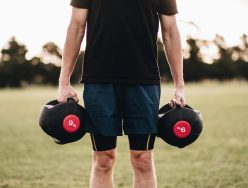People start an exercise program with good intentions to lose weight, gain energy, or to enjoy better health. Yet many quit soon after they start. Hence, it’s one of the key reasons why people seek out Personal Trainers – to sustain their motivation!
So here’s how to set up an exercise regime around Motivation Expert Michelle Segar’s MAPS [Meaning, Awareness, Permission, Strategy] framework, so clients stay inspired with exercising longer.
1. Meaning
a) The idea here is “when you change the meaning, you change the motivation.”
The meaning you assign to any form of exercise depends entirely on WHY you select it. Hence, if you understand the WHY of something you want to do (the reason you’ve chosen it), you’ll more likely embrace and sustain it.

b) Your goal should be to establish the client’s reasons for exercising, so as to replace the Wrong Whys with the Right Whys! Weight loss and better health are poor long-term motivators of exercise. While those are *good* reasons to spark exercising, they lack the meaning that truly motivates us long-term. For example, building good health seldom excites people long enough for them to actually achieve the payoff. Having fun, on the other hand, is a good motivator once you find an activity you like.
c) It’s also about uncovering their higher-level reasons for exercising. So dig deeper: Why do they care about obtaining those particular benefits from exercise? What would losing weight or better health mean to them on a daily basis? The more motivated tend to exercise to enhance the quality of their daily lives, to create a sense of well-being, a feeling of being energized and balanced. In doing so, they have found a way to get *immediate* gratification from exercise.
The Right Whys motivate us because they are relevant to our daily lives and are personally meaningful. “Exercise today to feel good today” is a more motivational message than the promise of health, wellness, and beauty somewhere in the future! More importantly, starting and stopping exercise programs provides scant benefit and only perpetuates a cycle of failure.
d.) When we lead with the Wrong Whys, exercise becomes a chore and who does chores with sustained enthusiasm?! So look to transform the meaning of exercise from a chore into “a gift to yourself” Clients can then look forward to having “chill out” or “me” time by engaging in fun, regenerative activities.
This is very different to someone (like their doctor) telling them they must do something (which turns into a should). Note that “shoulds” are bad motivators. Most people automatically hate to do anything they feel they MUST do.
e) Adopt an ‘Everything Counts’ Mentality:
Lower intensity levels, such as hiking, yoga, Pilates, and stretching have their place especially with those leading hectic lifestyles. Indeed, a wide variety of physical activities can be beneficial mentally and physically and complement tougher routines or pounding workouts.
Remind them too that functional fitness is a lifelong process, not a target they have to hit. If we force ourselves to exercise in ways that feel bad, we’ll likely feel depleted and even stressed from forcing ourselves to do something that deep down we didn’t want to do.
So teach clients to think of structured exercise (gym) and informal exercise (daily life) as equally valid and important in terms of overall health and wellbeing. Enjoying movement outside of the gym is likely to make them more likely to come back to the gym for more structured PT sessions. Encourage them to take on enjoyable, fun activities that physically energize them and that leave them with a positive feeling.
Can you see how encouraging clients to exercise outside of the gym may help them forge a better, lifelong partnership with physical activity? And ultimately with you, their Coach?
2. Awareness
Self-awareness enables clients to make informed judgments about their physical activities that give them pleasure and enhance their health.
Awareness also supplies them with useful insights about which activities motivate them the most and the least. For example, to lose weight, people often choose exercises they hate in order to burn the maximum number of calories. However, because most people loathe such exercises, they do them only briefly and then quit. Help clients become aware that their health and well-being does not exist in a vacuum but in the context of their busy, complex and often unpredictable day-to-day life.
The Right Whys spring from positive emotions. The right physical activity choices can act as a magic elixir that makes them feel great. It builds energy. It improves their mood. It makes them want to keep moving. It’s about sufficient awareness to engage in physical activities that are right for them for the right reasons (theirs!).
3. Permission
For many people, this goes against the grain. They act as if their lives aren’t their own.
They devote their time to the benefit of other people, their children, spouses, relatives and friends and their work. So get clients to think how their life and emotions would change if they gave themselves permission to make caring for themselves a priority and to make time for enjoyable exercise.
Many people hesitate to prioritize self-care because of certain social messages that carry enormous weight. Messages saying that you must be a good provider or a good parent can crowd out everything else. They influence people who want to devote some of their time to fun physical activities but find that the urge to exercise and playful activities conflict with the imperative to be selfless.
Yet setting time aside for physical activity can make or break their health and sense of wellbeing. Remind them they’ll be a better spouse, parent, and colleague if they are healthy and well. Making time for themselves brings an important personal statement to life: They are in charge of what they do and are the ultimate gatekeeper of their life. Self-care isn’t optional. Their ultimate success depends on it. Being active every day in enjoyable ways is essential to our daily functioning and to fostering what matters most in life.
4. Strategy
- Life often intrudes on our most resolute plans to stay active, so it helps to have well-crafted strategies for making exercising a priority like:
- List the fun physical activities that also provide the health/fitness benefits your client wants.
- Schedule when they will do them. Plan the weekly logistics. Review how well it works.
- Confront challenges, not roadblocks (reframe difficulties as challenges and not as impediments).
- Bring friends and family on board. The changes clients make in their life affect the people around them too.
- Be flexible around scheduling, be able to improvise, set realistic expectations, have solutions readily available.
- Having a flexible mindset also helps clients feel successful, which means happy, retained clients.
- Get clients to listen to their body and adjust accordingly to personal or external stressors.
- Evaluate and recalibrate workout intensities with compassionate nonjudgment.
The Key Take-Aways
“What sustains us, we sustain.” Michelle Segar
M: The meaning of any form of exercise depends on the client’s reasons for selecting it.
A: Without greater awareness, clients can’t make substantial changes in their life.
P: Give your clients permission to make time for themselves and their own well-being.
S: Craft a reasonable strategy for planning around the disruptions and roadblocks that will inevitably arise.
Adapted from “No Sweat: How the Simple Science of Motivation Can Bring You a Lifetime of Fitness” by Michelle Segar
Was this Article Helpful?
If this article was helpful to you, please consider linking this article to your own blog or sharing this through the social buttons below. You will also find other great articles at “Personal and Professional Development“.
- 10shares
- 7Facebook
- 2Twitter
- 0Pinterest
- 1LinkedIn
Noel Lyons
Latest posts by Noel Lyons
- How To Help Clients ReFocus and ReConnect With Themselves! - January 23, 2017
- The Five Steps To Follow To Achieve Lasting Change - December 2, 2016
- How To Motivate Your Clients to Stay Exercising With MAPS - November 9, 2016


















